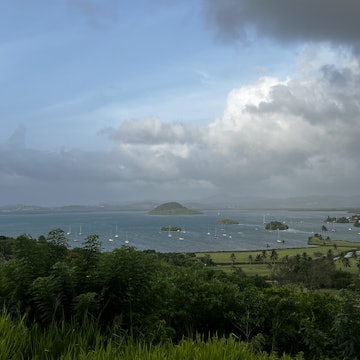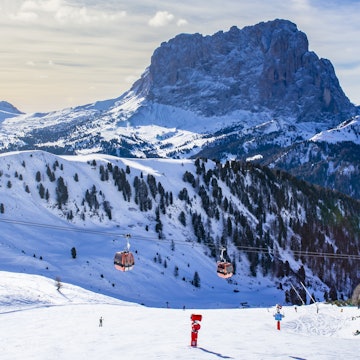

The rooftops in Lille © Meiqianbao / Shutterstock
Just an hour north of Paris by high-speed train, and with fast, direct rail links to London and Brussels, Lille makes an accessible, eco-friendly city break. And there's plenty to fill a weekend: France's fourth-largest city has an exquisite old town filled with ornate French and Flemish architecture, unique cuisine that incorporates the area's renowned beer, sublime art museums, and cutting-edge cultural centres. Its design studios and artisan shops will take centre stage throughout 2020 when Lille is France's first World Design Capital.
Here's how to get the most out of a three-day visit.

Day one: architecture and fine art
Lille's Flamboyant Gothic–style Palais Rihour makes an ideal starting point. The mid-1400s building is home to the tourist office: pick up a City Pass (there are 24-, 48- and 72-hour versions), which covers entry to key museums and attractions in the greater Métropole Européenne de Lille (MEL) area, as well as public transport.
Place Rihour is footsteps from Lille's grand square, place du Général de Gaulle, which is ringed by elaborate buildings including the Flemish Renaissance former stock exchange Vieille Bourse. Pop into its colonnaded interior to browse its stalls selling used books, vinyl and vintage advertising posters. Exiting on its eastern side brings you out on place du Théâtre, graced by the early 20th-century neo-Flemish Chambre de Commerce, topped by Lille's signature 76m-high gilded clock tower; and, from the same era, the adjacent Opéra.

After lunch at one of the old town's enticing bakery-cafes, such as 1833-opened Boulangerie Brier, zip up the Unesco-listed belfry of Lille's Hôtel de Ville (town hall) for sweeping city views. Then spend the afternoon exploring one of France's finest arts museums, the 1892-inaugurated Palais des Beaux Arts. Archaeological finds and medieval works are located in its basement, with pottery and a temporary exhibition space on the ground floor, but the highlight is the top floor. This succession of galleries contains a treasure chest of works by masters such as Rodin, Renoir, Picasso, Delacroix, Manet and Monet (including one of his impressionist paintings in the series, Houses of Parliament, London).
Rue de Gand is the city's premier dining strip, lined with crêperies, bistros and estaminets (Flemish-style taverns); try the hop-filled Le Bistrot Lillois for local specialities like carbonade flamande (braised beef slow-cooked with beer, onions, brown sugar and gingerbread). Plenty of bars on the same street make it a great place to continue the evening, or catch an opera, ballet or classical concert back at the city's opera house.

Day two: local designers and chocolate shops
Trains connect the centre of Lille with the northern area of Roubaix, where La Piscine Musée d'Art et d'Industrie is a must-see. Renovations in 2018 expanded its exhibition space, and this glorious art deco municipal swimming pool has been repurposed as a fine and applied arts museum, with sculptures reflected in the water-filled pool. Original tiles line the former changing rooms, which are now nooks displaying artworks.
La Piscine has an excellent modern French restaurant. Next door there's a fabulous organic cafe at Maisons de Mode, where you'll find locally crafted fashion, accessories and shoes by up-and-coming designers. Maisons de Mode's workshops also fan out in the surrounding streets; there's a second location 3km southwest of the centre.

For more shopping, return to Lille's old town boutiques. Momentum displays furniture, ceramics, textiles and other locally designed homewares. Chocolates and sweets at Meert are showcased in an enchanting early 19th-century former pharmacy. Stop by its tearoom to try the renowned gaufres (waffles) with Madagascan vanilla, or visit the gourmet restaurant here. More chocolate shops proliferate throughout the old town, including the boutique of lillois (Lille native) Quentin Bailly. The handmade ice creams here are a summertime treat.
Hidden in a cobbled courtyard, L'Assiette du Marché rambles over a series of romantic rooms and serves standout, unexpectedly contemporary French cuisine. Afterwards, rue Doudin and rue Royale are good bets for bars, or catch a live music gig at Le Splendid, inside an erstwhile cinema.

Day three: cultural events and local beer
Kick off your third day at Musée d'Art Moderne, d'Art Contemporain et d'Art Brut – LaM, 9km east at Villeneuve-d'Ascq (easily reached by metro then bus), where works by artists including Braque, Miró, Modigliani and Picasso are displayed in the museum and sculpture park.
Check Lille3000 for details of exhibitions, concerts, festivals and more at two of Lille's coolest cultural centres. Gare Saint Sauveur sprawls over a former freight-train station; there's a great onsite restaurant serving French standards like œufs mayonnaise (mayo-stuffed hard-boiled eggs) and tartare de bœuf (beef tartare). Around 1km north, opposite the vast Euralille shopping mall, Le Tripostal occupies an enormous red-brick building that was originally a postal sorting centre.
Estaminet Au Vieux de la Vieille is a top spot for a final Flemish meal (try its Welsh au Maroilles – beer-soaked bread, ham and mustard topped with Maroilles cheese); on a sunny day, the best seats are on pretty place aux Oignons. Before leaving, stock up on Lille-brewed beers at specialist purveyor L'Abbaye des Saveurs, or right at the source at microbrewery Célestin's.

When to go
Lille makes a perfect long-weekend escape, with rates dropping (often dramatically) on Friday and Saturday nights. Tack on extra days late in the week, when more places are open, and in particular skip Tuesdays, when most of the city's museums close.
Where to stay in Lille
The city's hippest hostel accommodation is Gastama, in the heart of the old town and with a pumping in-house bar, while the 2018-opened Eklo Lille is an eco-conscious hybrid hostel/hotel with a restaurant in a nearby shipping container.
For midrange accommodation in the pedestrian centre, Hotel Kanaï is a superb spot, with regional cheeses and local jams on the menu at breakfast. Antique-filled Brueghel has a charming wood-panelled lobby.
Lille's design credentials are on show at guesthouse Koh' Coon, with three rooms (Scandinavian, Riad and World Tour) all with Jacuzzis forming centrepieces of the eye-popping spaces; and at Hôtel L'Arbre Voyageur, in the stunningly post-Soviet former Polish consulate, with an on-site luxury deli, and organic and cocktail-pairing restaurants.
Getting there
Train
The Eurostar zips between Lille's gleaming Gare Lille-Europe and London St Pancras in 90 minutes. Fast trains run between Gare Lille-Europe and Brussels-Midi in just 35 minutes, and between both Gare Lille-Europe and the older Gare Lille-Flandres and Paris Gare du Nord in 60 minutes. All services typically run hourly or better.
Bus
Eurolines and Flixbus serve European destinations; Isilines and Ouibus run to destinations throughout France.
Air
From Lille you can reach Paris' Charles de Gaulle Airport in an hour by direct train, but the city also has its own small airport, the Aéroport de Lille, serving a handful of French and European destinations.
https://shop.lonelyplanet.com/products/france-travel-guide-13
















